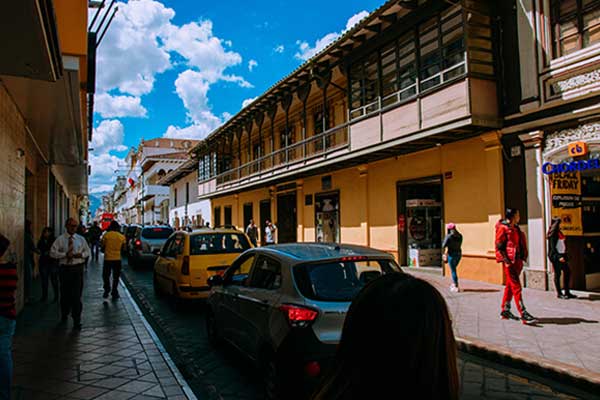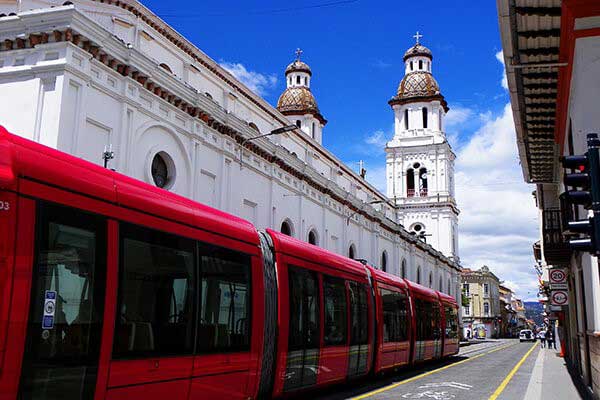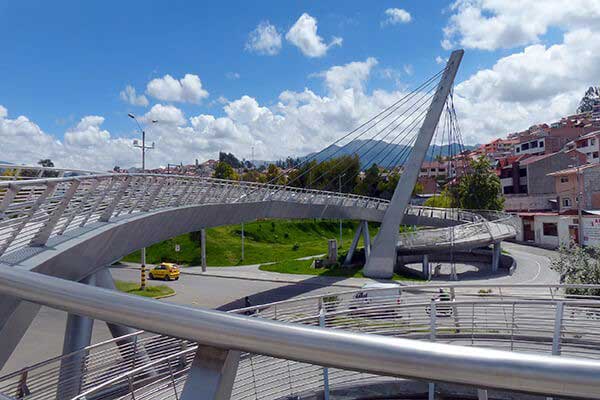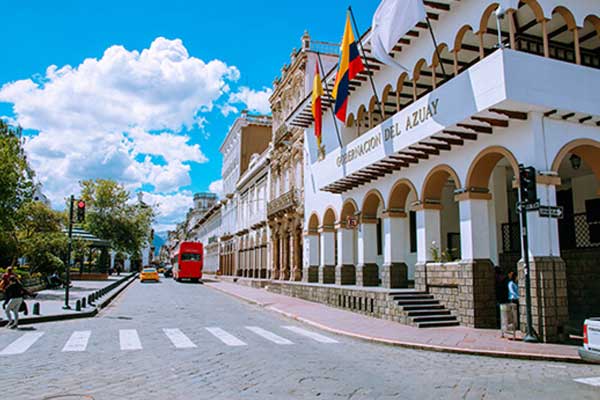“HOOORSE!” I screeched, prompting Ken to swerve at the last minute to avoid the hapless quadruped that had appeared seemingly out of nowhere right in front of us. Just as our nerves had settled down, a couple of skittish dogs trotting along the verge up ahead saw something on the other side that must have been desperately urgent as they suddenly bolted across the road, causing Ken to slam on the brakes once again. And in this nail-biting fashion, our five-hour drive from Cuenca to Vilcabamba continued, dodging livestock, dogs, falling rocks, potholes, and the occasional meandering biped. Driving in Ecuador was proving to be a little more challenging and certainly more adrenaline-inducing than in the States.
When we first moved to Cuenca, we were pretty sure, like many expats, that we didn’t want to incur the expense and perceived hassle associated with owning a vehicle. One of the sentiments I often overhear at expat hangouts around town is, “We’re so happy to not need a car here.” And it’s certainly true that you don’t need a car to get around Cuenca, or most of the country for that matter. Taxis are ludicrously cheap (the average ride is about $2 within the city), and public transport throughout the country is widespread and very affordable (mostly buses and small vans). After a while, though, we started to feel a little limited without our own vehicle, and about nine months after moving to Ecuador we finally caved in. So here are the ins and outs of car ownership in Ecuador, and what you might want to know before deciding to buy or not to buy…
1. Expenses

Maintenance, Fuel, Insurance, Registration: One of the reasons expats often give for not wanting to own a vehicle in Ecuador is that it is expensive and they don’t want to pay all the costs for vehicle maintenance, fuel, insurance, registration, etc. This reasoning gains even more weight given how cheap and widespread public transport is in Cuenca, and in the country as a whole. Having lived for decades in the U.S. being burdened by heavy monthly payments for all of the above, many expats find it liberating to not need to incur these expenses in Ecuador. And this is a valid argument.
However, it’s not as expensive as you might think: most of the above costs are cheaper in Ecuador than in the States. For example, we pay $400 per year for full coverage insurance for our 2010 4WD Suzuki Grand Vitara; our registration fee for 2021 was less than $150 for the whole year (this varies depending on what type of vehicle you have; a “green tax” is also part of this fee, and is calculated according to the age and engine size of the vehicle); gasoline costs no more than in the U.S. (currently $2.55 per gallon for unleaded and only $1.90 per gallon for diesel); repairs, in our experience, cost about one-fifth of what they would in the U.S., mainly because labor rates are so much lower; and parts cost about the same as they do in the U.S.
Because taxis are so cheap, we generally don’t use our car for driving around the city. We use it for longer trips, such as heading into the mountains for hikes, or for exploring further afield in Ecuador.
Purchase Price: It is important to know that used vehicles are much more expensive than their equivalents in the States. You could expect to pay almost twice the amount you would for a 4WD used SUV, for example. And perhaps more than 20% to 30% more for a small, compact car such as a Nissan Sentra. However, to counterbalance that, the resale value does not depreciate much, so when the time comes to sell, you should be able–in theory–to recoup the majority of your money.
Oftentimes, new vehicles, particularly smaller compact cars, tend to cost about the same as in the U.S., and there are now a lot of new Chinese vehicles available in Ecuador for reasonable prices (though reports on their reliability vary!).
When it comes to the actual purchase of a vehicle, although the process can be a bit tedious, it doesn’t have to be stressful! Here’s why: for a couple hundred dollars, you can pay a local facilitator to seek out the kind of car you’re looking for, set up viewing appointments, negotiate on the asking price; and once you’ve found something you like, they will take care of the purchase transaction and registration paperwork. This is what we did, and it was worth every cent in our opinion. Our facilitator negotiated a reduced price that completely offset his $200 fee, and then some! This year, when it came to renewing our registration, we hired the same facilitator for just $40, thereby negating the need for us to wait in endless lines at the EMOV office (equivalent of the DMV) or go through the lengthy inspection process. Again, well worth the money.
Toll Roads: There are very few in Ecuador, and the ones that do exist are mostly located around Quito and are cheap–no more than one dollar, paid in cash.
2. Freedom of Movement

Many expats argue that public transport is more than sufficient for their daily needs of getting around. But we are avid hikers, and although there are plenty of buses that run through the mountains, their schedules are quite limiting and they definitely can’t get you to the more remote trailheads. One option is to hire a driver–usually one with a 4×4 pick-up truck, known locally as a “mixto.” However, this limits your ability for spontaneity, since you typically have to reserve the transportation the day before your hike. Given that the weather around Cuenca is notoriously unpredictable, you may well find yourself committed to a cold and wet hike. With your own vehicle, you can just wake up on a sunny day, and say “let’s go!” Also, you have to prearrange a time that the mixto driver will pick you up at the end of your hike, meaning that you have to stick to a schedule, again leaving less room for spontaneity.
Another option that many expats choose is to go on a guided hike, where transportation, guide, and food are included. This is a great way to meet other people, as well as enjoy a hike (or other outing) and learn interesting facts about the surrounding environment. Again, we prefer to do things on our own schedule and find our own way around with maps and guidebooks. So, that was a major motivator in us wanting to have our own transportation.
Another factor in buying a car was the ability to explore Ecuador at our own pace and get to the more remote places. Again, this is possible by public transport, but for us there is a great freedom in being able to stop exactly where we want to, at a time of our choosing; check out places that might pique our curiosity during a trip; be able to choose what time we set out, and not have to get up at the crack of dawn to catch a bus that will then make dozens of stops along the way to the final destination. I have nothing against bus travel–I made it around the whole of South America on buses in 2005, and had a great time, but I was in my 20s and didn’t mind being squeezed into an overloaded bus with too many people and a noticeable number of chickens. Now in my 40s, it’s nice to be able to travel more comfortably, listen to my own choice of music, and not be at the mercy of a maniacal driver hell-bent on overtaking trucks on blind corners! We also have a dog, and it’s much easier to take her with us in the car than to try to take her on public transport.
3. Driving Conditions

When it comes to driving conditions, I have to confess to using a bit of poetic license in my opening paragraph. It’s fair to say that you do have to be a little more alert in Ecuador than in the States, but road conditions are actually pretty good. Thanks to Chinese investment in infrastructure, Ecuador now has far more paved roads than it did 20 years ago, and the surface quality is generally good. The country’s constantly shifting geology does mean that cracks and potholes occur frequently, but there are always teams of workers out doing repairs. The main north-south route from Quito to Cuenca is really quite easy and scenic driving, and once you get used to the wandering animals, it’s not much different from driving in the States. We generally try to avoid driving at night, since roadworks may not be so well lit up as you would expect, and you may be more likely to encounter drunk drivers. But we have driven in several other Latin American countries–Mexico, Colombia, and Argentina–and can confidently say that Ecuador is by far the least stressful.
4. Obtaining an Ecuadorian License

If you are staying in Ecuador for three to six months on a tourist visa, you are allowed to drive on your foreign license for the duration of your stay. Anyone staying in the country longer–i.e. on a residency visa–is expected to obtain an Ecuadorian driver’s license, and it’s not a straightforward process.
In August 2021, a new law was passed authorizing foreign residents to essentially “exchange” their national license for an Ecuadorian one. This change will supposedly eliminate the requirement for foreign residents (those holding a valid cédula) to undergo the usual litany of tests required by the national transportation agency, ANT. The new law stipulates that you simply have to provide an apostilled copy of your driver’s record from your home country (which must be translated into Spanish and notarized too), as well as obtain a Red Cross blood-type test, and pay the relevant ANT fees.
However, at the time of writing, this new law is not yet being implemented by the ANT. This is common in Ecuador whenever a new law is passed, whether it be related to immigration, transportation, or anything else. Regulations and implementation procedures are often slow to follow, and it could be many months before the new law actually takes effect.
This means that for now, in addition to the above paperwork, you also still need to take a driving theory test in Spanish; and pass the examen psicosensométrico (audio and visual reflex test) at an ANT-accredited driving school. Once you have done all this, the fee is $142, which is obviously quite steep compared to the cost of obtaining a license in the U.S. Many expats don’t bother with this convoluted process, and just continue to drive with their U.S. licenses. But this is risky and you could find yourself in a fair amount of trouble with the police if they realize that you are in the country as a resident, not a tourist. There are many police checks on all roads throughout Ecuador, so it’s not a good idea to take your chances indefinitely.
Overall, I lean in favor of owning a vehicle, since it has really opened a lot of doors for us here in Cuenca, especially whenever we want to go anywhere with our four-legged travel companion, Sally. We want our experience in Ecuador to be as rewarding as possible, whether we stay for another two years or 20, and for us that means being able to get off the beaten track on our own terms and explore as much of this beautiful country as possible. The pros of vehicle ownership outweigh the cons for us, and yes, it is an extra expense, but it’s one that we’re happy to pay in order to have a more enriching experience in Ecuador. That being said, you can still get around Cuenca, and most of Ecuador in general, by yourself without having to own a vehicle, and with just some extra effort and planning, can still reap the rewards of living in such an incredibly diverse and culturally rich country. So, what are you waiting for? Get out there and start exploring!

Get Your Free Ecuador Report Here:
Learn more about Ecuador and other countries in our daily postcard e-letter. Simply enter your email address below and we'll send you a FREE REPORT - Ecuador: Live Well on Your Social Security.
This special guide covers real estate, retirement and more in Ecuador and is yours free when you sign up for our postcards below.
Related Articles
Two Weeks in Ecuador: Touring Quito, Cuenca, and Salinas
Quito Ecuador’s Capital Often called the “most beautiful big city in South America”
Loja, Ecuador: A City That Will Surprise You
Upcoming Conferences
The Only 2024 Fast Track Panama Conference
If your dream retirement involves stunning beaches… lush green mountains… a warm climate with no hurricanes… first-rate healthcare… incredible value for money (a couple can live well on $2,200 a month)… and the World’s #1 Retiree Discount Program…
Join our Panama experts and expats in February and discover why Panama could be your perfect paradise.
REGISTER NOW, SEATS LIMITED: EARLY BIRD DISCOUNT HERE


.png)